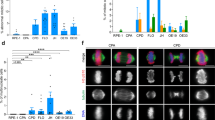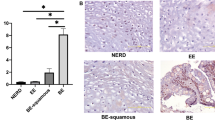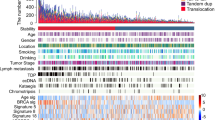Abstract
The partition-defective 3 (PAR-3) protein is implicated in the formation of tight junctions at epithelial cell–cell contacts. We investigated DNA copy number aberrations in human esophageal squamous cell carcinoma (ESCC) cell lines using a high-density oligonucleotide microarray and found a homozygous deletion of PARD3 (the gene encoding PAR-3). Exogenous expression of PARD3 in ESCC cells lacking this gene enhanced the recruitment of zonula occludens 1 (ZO-1), a marker of tight junctions, to sites of cell–cell contact. Conversely, knockdown of PARD3 in ESCC cells expressing this gene caused a disruption of ZO-1 localization at cell–cell borders. A copy number loss of PARD3 was observed in 15% of primary ESCC cells. Expression of PARD3 was significantly reduced in primary ESCC tumors compared with their nontumorous counterparts, and this reduced expression was associated with positive lymph node metastasis and poor differentiation. Our results suggest that deletion and reduced expression of PARD3 may be a novel mechanism that drives the progression of ESCC.
This is a preview of subscription content, access via your institution
Access options
Subscribe to this journal
Receive 50 print issues and online access
$259.00 per year
only $5.18 per issue
Buy this article
- Purchase on Springer Link
- Instant access to full article PDF
Prices may be subject to local taxes which are calculated during checkout





Similar content being viewed by others
References
Aoki T, Mori T, Du X, Nisihira T, Matsubara T, Nakamura Y . (1994). Allelotype study of esophageal carcinoma. Genes Chromosomes Cancer 10: 177–182.
Assémat E, Bazellières E, Pallesi-Pocachard E, Le Bivic A, Massey-Harroche D . (2008). Polarity complex proteins. Biochim Biophys Acta 1778: 614–630.
Berggren P, Kumar R, Sakano S, Hemminki L, Wada T, Steineck G et al. (2003). Detecting homozygous deletions in the CDKN2A(p16(INK4a))/ARF(p14(ARF)) gene in urinary bladder cancer using real-time quantitative PCR. Clin Cancer Res 9: 235–242.
Chen X, Macara IG . (2005). Par-3 controls tight junction assembly through the Rac exchange factor Tiam1. Nat Cell Biol 7: 262–269.
Enzinger PC, Mayer RJ . (2003). Esophageal cancer. N Engl J Med 349: 2241–2252.
Fang CM, Xu YH . (2001). Down-regulated expression of atypical PKC-binding domain deleted asip isoforms in human hepatocellular carcinomas. Cell Res 11: 223–229.
Friend SH, Bernards R, Rogelj S, Weinberg RA, Rapaport JM, Albert DM et al. (1986). A human DNA segment with properties of the gene that predisposes to retinoblastoma and osteosarcoma. Nature 323: 643–646.
Gao L, Macara IG, Joberty G . (2002). Multiple splice variants of Par3 and of a novel related gene, Par3L, produce proteins with different binding properties. Gene 294: 99–107.
Hahn SA, Schutte M, Hoque AT, Moskaluk CA, da Costa LT, Rozenblum E et al. (1996). DPC4, a candidate tumor suppressor gene at human chromosome 18q21.1. Science 271: 350–353.
Hirose T, Karasawa M, Sugitani Y, Fujisawa M, Akimoto K, Ohno S et al. (2006). PAR3 is essential for cyst-mediated epicardial development by establishing apical cortical domains. Development 133: 1389–1398.
Humbert PO, Dow LE, Russell SM . (2006). The Scribble and Par complexes in polarity and migration: friends or foes? Trends Cell Biol 16: 622–630.
Inagaki Y, Yasui K, Endo M, Nakajima T, Zen K, Tsuji K et al. (2008). CREB3L4, INTS3, and SNAPAP are targets for the 1q21 amplicon frequently detected in hepatocellular carcinoma. Cancer Genet Cytogenet 180: 30–36.
Izumi Y, Hirose T, Tamai Y, Hirai S, Nagashima Y, Fujimoto T et al. (1998). An atypical PKC directly associates and colocalizes at the epithelial tight junction with ASIP, a mammalian homologue of Caenorhabditis elegans polarity protein PAR-3. J Cell Biol 143: 95–106.
Joberty G, Petersen C, Gao L, Macara IG . (2000). The cell-polarity protein Par6 links Par3 and atypical protein kinase C to Cdc42. Nat Cell Biol 2: 531–539.
Kamb A, Gruis NA, Weaver-Feldhaus J, Liu Q, Harshman K, Tavtigian SV et al. (1994). A cell cycle regulator potentially involved in genesis of many tumor types. Science 264: 436–440.
Kemphues KJ, Priess JR, Morton DG, Cheng NS . (1988). Identification of genes required for cytoplasmic localization in early C. elegans embryos. Cell 52: 311–320.
Kennedy GC, Matsuzaki H, Dong S, Liu WM, Huang J, Liu G et al. (2003). Large-scale genotyping of complex DNA. Nat Biotechnol 21: 1233–1237.
Kohjima M, Noda Y, Takeya R, Saito N, Takeuchi K, Sumimoto H . (2002). PAR3beta, a novel homologue of the cell polarity protein PAR3, localizes to tight junctions. Biochem Biophys Res Commun 299: 641–646.
Li J, Yen C, Liaw D, Podsypanina K, Bose S, Wang SI et al. (1997). PTEN, a putative protein tyrosine phosphatase gene mutated in human brain, breast, and prostate cancer. Science 275: 1943–1947.
Lin D, Edwards AS, Fawcett JP, Mbamalu G, Scott JD, Pawson T . (2000). A mammalian PAR-3–PAR-6 complex implicated in Cdc42/Rac1 and aPKC signalling and cell polarity. Nat Cell Biol 2: 540–547.
Macara IG . (2004). Parsing the polarity code. Nat Rev Mol Cell Biol 5: 220–231.
Mei R, Galipeau PC, Prass C, Berno A, Ghandour G, Patil N et al. (2000). Genome-wide detection of allelic imbalance using human SNPs and high-density DNA arrays. Genome Res 10: 1126–1137.
Nagayama K, Kohno T, Sato M, Arai Y, Minna JD, Yokota J . (2007). Homozygous deletion scanning of the lung cancer genome at a 100-kb resolution. Genes Chromosomes Cancer 46: 1000–1010.
Nannya Y, Sanada M, Nakazaki K, Hosoya N, Wang L, Hangaishi A et al. (2005). A robust algorithm for copy number detection using high-density oligonucleotide single nucleotide polymorphism genotyping arrays. Cancer Res 65: 6071–6079.
Stevenson BR, Siliciano JD, Mooseker MS, Goodenough DA . (1986). Identification of ZO-1: a high molecular weight polypeptide associated with the tight junction (zonula occludens) in a variety of epithelia. J Cell Biol 103: 755–766.
Suzuki A, Ohno S . (2006). The PAR–aPKC system: lessons in polarity. J Cell Sci 119: 979–987.
Vizcaino AP, Moreno V, Lambert R, Parkin DM . (2002). Time trends incidence of both major histologic types of esophageal carcinomas in selected countries, 1973–1995. Int J Cancer 99: 860–868.
Wodarz A, Näthke I . (2007). Cell polarity in development and cancer. Nat Cell Biol 9: 1016–1024.
Yasui K, Imoto I, Fukuda Y, Pimkhaokham A, Yang ZQ, Naruto T et al. (2001). Identification of target genes within an amplicon at 14q12–q13 in esophageal squamous cell carcinoma. Genes Chromosomes Cancer 32: 112–118.
Zhao X, Li C, Paez JG, Chin K, Jänne PA, Chen TH et al. (2004). An integrated view of copy number and allelic alterations in the cancer genome using single nucleotide polymorphism arrays. Cancer Res 64: 3060–3071.
Zitzelsberger H, Hieber L, Richter H, Unger K, Briscoe CV, Peddie C et al. (2004). Gene amplification of atypical PKC-binding PARD3 in radiation-transformed neoplastic retinal pigment epithelial cell lines. Genes Chromosomes Cancer 40: 55–59.
Acknowledgements
This study was supported by Grants-in-Aid for Scientific Research (18390223 and 20590408) from the Japan Society for the Program of Science (KY).
Author information
Authors and Affiliations
Corresponding author
Additional information
Supplementary Information accompanies the paper on the Oncogene website (http://www.nature.com/onc)
Rights and permissions
About this article
Cite this article
Zen, K., Yasui, K., Gen, Y. et al. Defective expression of polarity protein PAR-3 gene (PARD3) in esophageal squamous cell carcinoma. Oncogene 28, 2910–2918 (2009). https://doi.org/10.1038/onc.2009.148
Received:
Revised:
Accepted:
Published:
Issue Date:
DOI: https://doi.org/10.1038/onc.2009.148
Keywords
This article is cited by
-
ARHGAP39 is a prognostic biomarker involved in immune infiltration in breast cancer
BMC Cancer (2023)
-
TMEM25 is a Par3-binding protein that attenuates claudin assembly during tight junction development
EMBO Reports (2023)
-
High expression of PARD3 predicts poor prognosis in hepatocellular carcinoma
Scientific Reports (2021)
-
The polarity protein PARD3 and cancer
Oncogene (2021)
-
Apical–basal polarity inhibits epithelial–mesenchymal transition and tumour metastasis by PAR-complex-mediated SNAI1 degradation
Nature Cell Biology (2019)



